Palpation Examination
The palpation examination covers taking pulse and pressing the skin, hands, feet, chest, abdomen and other areas to check for abnormal body signs. Pulse examination is perhaps the most important aspect of the whole examination.
Feeling the pulse
According to TCM, blood flowing in the vessels is governed by the heart and commanded by qi (vital energy). Whatever the causes of the disease, abnormal changes can be reflected by the pulse, and from this arise changes in the pulse image. Pulse-taking helps in judging the location and nature of a disease and the prosperity and decline of qi (vital energy) and pathogens to infer prognosis of the disease and form the basis for treatment.The common location for pulse taking is above the wrist where the radial artery throbs; the first three fingers are pressed on it, which are named: the cun, guan and chi regions. (Please see picture for reference). There are various descriptions concerning the relationship between these three regions and their corresponding organs. It is generally acknowledged that the three regions of the left hand reflect respectively the conditions of the heart, liver and kidneys; and those of the right hand reflect the conditions of the lungs, spleen and kidneys.
 The different points of the pulse felt on the wrists are correspond to different organs.
The different points of the pulse felt on the wrists are correspond to different organs. | Locations | Chu | Guan | Chi |
| Left wrist | Heart | Liver | Kidney |
| Right wrist | Lung | Spleen | vital gate |
When feeling the pulse, the patient places the arm at the same level with the heart. The wrist is extended and the palm faces upward. This position facilitates smooth circulation of qi (vital energy) and blood. In general, physicians use his left hand to check the right side's pulse, and then the right hand to check the left side's pulse. They will use three fingers to press on the wrist with the same strength, and then each finger feel separately according to the actual pathological conditions. Each pulse reading should be at least 50 pulse counts.
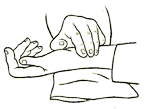 |
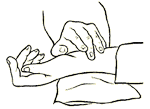 |
| Method for pulse taking | |
The pulse is differentiated in terms of depth, speed, strength, shape and rhythm. Different conditions of the pulse indicate different disharmony patterns. A normal pulse is smooth, even and forceful with the frequency of four beats per breath (approximate 60/min). However, the pulse feelings may slight vary due to age, sex, and body constitution, emotional state and climatic changes. Special attention should be paid to distinguishing it from an abnormal pulse.

Common abnormal pulse signs
| Pulse signs | Characteristics | Clinical significance |
|---|---|---|
| Floating pulse (fu mai) | Pulse responds to finger on light pressure but becomes weak on heavy pressure | Exterior syndrome |
| Deep pulse (chen mai) | Not clear with light pressing; clear with heavy pressing | Interior syndrome |
| Slow pulse (chi mai) | Rate is less than 4 beats per breath (less than 60 beats/min) | Cold syndrome |
| Rapid pulse (shu mai) | Rate is more than 5 beats per breath (more than 90 beats/min) | Heat syndrome |
| Deficient pulse (xu mai) | Lack of force, empty and vacuous with pressure | Deficiency in qi and blood |
| Excess pulse (shi mai) | Forceful with touching and pressing | Excess syndrome, heat syndrome |
| Rolling pulse (hua mai) | Smooth and flowing like pearls rolling on a dish. | Phlegm and fluid detention, qi stagnation, excess heat and food retention. It is also usual in healthy people with ample qi (vital energy) and blood, and in pregnant women. |
| Hesitant pulse (se mai) | Rough and uneven, opposite to rolling pulse. | Stagnation of qi or blood, impairment of essence, and deficiency of blood. |
| Thready pulse (xi mai) | Feels like a fine thread but is very distinct and clear. | Damp syndrome, physical overstrain, or deficiency of both qi and blood. |
| Surging pulse (hong mai) | Feels broad, large and forceful like powerful waves that ebb and flow. | Excessive heat or yang |
| Taut pulse (xuan mai) | Feels taut, straight and long, like the string of a violin | Disorders of the liver and gall-bladder, painful conditions, and phlegm and static fluid detention. |
| Tense pulse (jin mai) | Feels tight and forceful like a stretched rope. | Cold syndrome, and painful conditions |
| Knotted pulse (jie mai) | Pulse is slow and gradual with irregular or missed beats. | Serious conditions with impairment of qi and blood and declining yang-qi. |
Since the development of disease is complicated, the above abnormal pulses often not appear in their pure forms; two or more forms may be felt at the same time. For example, a floating and tense pulse indicates exterior cold syndromes, and a floating and rapid pulse indicates exterior heat syndromes. It should be kept in mind that comprehensive evaluation through the four examination skills is necessary, taking pulse alone is not enough to determine a proper diagnosis.
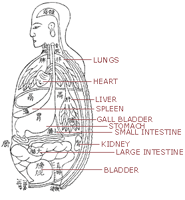
Pressing examination
 This methods enables a doctor to infer the location, nature and state of an illness by touching, feeling, pushing and pressing certain parts of the patient's body, for example touching the skin and muscles, pressing the chest and abdomen, or acupoints.
This methods enables a doctor to infer the location, nature and state of an illness by touching, feeling, pushing and pressing certain parts of the patient's body, for example touching the skin and muscles, pressing the chest and abdomen, or acupoints.- Skin and muscles: signs like cold, feverish, moist, dry, or swelling on skin and muscles tell about the conditions of yang qi or pathogens that have invaded the body. In general, if pathogens are in excess, the temperature is high; when the yang qi is depleted, the temperature is low.
- Chest and abdomen: Important organs reside here and signs like fullness, hardness, heat or pain in specific areas can indicate which organ is not functioning properly. For example, in the case of liver deficiency, the patient may experience hypochondriac pain (pain beneath the ribs), which can be comforted by massage, and the area feels weak and empty when it is pressed.
- Acu-points: Acupoints are places for organs' qi to meet on the body surface; abnormal sensation in these points reflects disease of the organs. For example, pain in the dan shu (Bl 19) may indicate a gall-bladder disharmony, while pain in the gan shu (Bl 18) and qi men (Lr 14) may indicate liver disharmony.
| Front | Back |
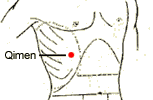 |
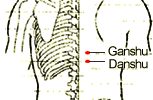 |
| Pressing pain in the qi men, and gan shu indicate liver disharmony, while pain in the dan shu indicates a gallbladder problem. | |


